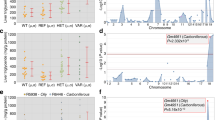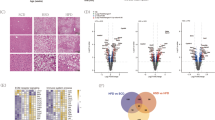Abstract
Lipin proteins including Lipin 1–3 act as transcriptional co-activators and phosphatidic acid phosphohydrolase enzymes, which play crucial roles in lipid metabolism. However, little is known about the function of Lipin3 in triglyceride (TG) metabolism. Here, we identified a novel mutation (NM_001301860: p.1835A>T/p.D612V) of Lipin3 in a large family with hypertriglyceridemia (HTG) and obesity through whole-exome sequencing and Sanger sequencing. Functional studies revealed that the novel variant altered the half-life and stability of the Lipin3 protein. Hence, we generated Lipin3 heterozygous knockout (Lipin3-heKO) mice and cultured primary hepatocytes to explore the pathophysiological roles of Lipin3 in TG metabolism. We found that Lipin3-heKO mice exhibited obvious obesity, HTG, and non-alcoholic fatty liver disorder. Mechanistic study demonstrated that the haploinsufficiency of Lipin3 in primary hepatocytes may induce the overexpression and abnormal distribution of Lipin1 in cytosol and nucleoplasm. The increased expression of Lipin1 in cytosol may contribute to TG anabolism, and the decreased Lipin1 in nucleoplasm can reduce PGC1α, further leading to mitochondrial dysfunction and reduced TG catabolism. Our study suggested that Lipin3 was a novel disease-causing gene inducing obesity and HTG. We also established a relationship between Lipin3 and mitochondrial dysfunction.
Similar content being viewed by others
References
Polyzos SA, Kountouras J, Mantzoros CS. Obesity and nonalcoholic fatty liver disease: from pathophysiology to therapeutics. Metabolism 2019; 92: 82–97
Blüher M. Obesity: global epidemiology and pathogenesis. Nat Rev Endocrinol 2019; 15(5): 288–298
Piché ME, Tchernof A, Després JP. Obesity phenotypes, diabetes, and cardiovascular diseases. Circ Res 2020; 126(11): 1477–1500
Tsai AG, Bessesen DH. Obesity. Ann Intern Med 2019; 170(5): ITC33–ITC48
Goodarzi MO. Genetics of obesity: what genetic association studies have taught us about the biology of obesity and its complications. Lancet Diabetes Endocrinol 2018; 6(3): 223–236
Claussnitzer M, Dankel SN, Kim KH, Quon G, Meuleman W, Haugen C, Glunk V, Sousa IS, Beaudry JL, Puviindran V, Abdennur NA, Liu J, Svensson PA, Hsu YH, Drucker DJ, Mellgren G, Hui CC, Hauner H, Kellis M. FTO obesity variant circuitry and adipocyte browning in humans. N Engl J Med 2015; 373(10): 895–907
Xiang R, Fan LL, Huang H, Chen YQ, He W, Guo S, Li JJ, Jin JY, Du R, Yan R, Xia K. Increased reticulon 3 (RTN3) leads to obesity and hypertriglyceridemia by interacting with heat shock protein family A (Hsp70) member 5 (HSPA5). Circulation 2018; 138(17): 1828–1838
Chen C, Wang H, Chen B, Chen D, Lu C, Li H, Qian Y, Tan Y, Weng H, Cai L. Pex11a deficiency causes dyslipidaemia and obesity in mice. J Cell Mol Med 2019; 23(3): 2020–2031
Lei X, Wong GW. C1q/TNF-related protein 2 (CTRP2) deletion promotes adipose tissue lipolysis and hepatic triglyceride secretion. J Biol Chem 2019; 294(43): 15638–15649
Moslehi A, Hamidi-Zad Z. Role of SREBPs in liver diseases: a mini-review. J Clin Transl Hepatol 2018; 6(3): 332–338
Hauck AK, Huang Y, Hertzel AV, Bernlohr DA. Adipose oxidative stress and protein carbonylation. J Biol Chem 2019; 294(4): 1083–1088
de Mello AH, Costa AB, Engel JDG, Rezin GT. Mitochondrial dysfunction in obesity. Life Sci 2018; 192: 26–32
Han L, Shen WJ, Bittner S, Kraemer FB, Azhar S. PPARs: regulators of metabolism and as therapeutic targets in cardiovascular disease. Part I: PPAR-a. Future Cardiol 2017; 13(3): 259–278
Reue K. The lipin family: mutations and metabolism. Curr Opin Lipidol 2009; 20(3): 165–170
Finck BN, Gropler MC, Chen Z, Leone TC, Croce MA, Harris TE, Lawrence JCJr, Kelly DP. Lipin 1 is an inducible amplifier of the hepatic PGC-1alpha/PPARalpha regulatory pathway. Cell Metab 2006; 4(3): 199–210
Chen Y, Rui BB, Tang LY, Hu CM. Lipin family proteins-key regulators in lipid metabolism. Ann Nutr Metab 2015; 66(1): 10–18
Romani P, Brian I, Santinon G, Pocaterra A, Audano M, Pedretti S, Mathieu S, Forcato M, Bicciato S, Manneville JB, Mitro N, Dupont S. Extracellular matrix mechanical cues regulate lipid metabolism through Lipin-1 and SREBP. Nat Cell Biol 2019; 21(3): 338–347
Casas J, Meana C, López-López JR, Balsinde J, Balboa MA. Lipin-1-derived diacylglycerol activates intracellular TRPC3 which is critical for inflammatory signaling. Cell Mol Life Sci 2021; 78(24): 8243–8260
Chae M, Jung JY, Bae IH, Kim HJ, Lee TR, Shin DW. Lipin-1 expression is critical for keratinocyte differentiation. J Lipid Res 2016; 57(4): 563–573
Reue K, Zhang P. The lipin protein family: dual roles in lipid biosynthesis and gene expression. FEBS Lett 2008; 582(1): 90–96
Fan LL, Ding DB, Huang H, Chen YQ, Jin JY, Xia K, Xiang R. A de novo mutation of SMYD1 (p. F272L) is responsible for hypertrophic cardiomyopathy in a Chinese patient. Clin Chem Lab Med 2019; 57(4): 532–539
Huang H, Guo S, Chen YQ, Liu YX, Jin JY, Liang Y, Fan LL, Xiang R. Increased RTN3 phenocopies nonalcoholic fatty liver disease by inhibiting the AMPK-IDH2 pathway. MedComm (2020) 2023; 4(2): e226
Shi Q, Ge Y, Sharoar MG, He W, Xiang R, Zhang Z, Hu X, Yan R. Impact of RTN3 deficiency on expression of BACE1 and amyloid deposition. J Neurosci 2014; 34(42): 13954–13962
Csaki LS, Dwyer JR, Li X, Nguyen MH, Dewald J, Brindley DN, Lusis AJ, Yoshinaga Y, de Jong P, Fong L, Young SG, Reue K. Lipin-1 and lipin-3 together determine adiposity in vivo. Mol Metab 2014; 3(2): 145–154
Péterfy M, Phan J, Xu P, Reue K. Lipodystrophy in the fld mouse results from mutation of a new gene encoding a nuclear protein, lipin. Nat Genet 2001; 27(1): 121–124
Bi L, Jiang Z, Zhou J. The role of lipin-1 in the pathogenesis of alcoholic fatty liver. Alcohol Alcohol 2015; 50(2): 146–151
Barroso E, Astudillo AM, Balsinde J, Vázquez-Carrera M. PPARβ/δ Activation prevents hypertriglyceridemia caused by a high fat diet. Involvement of AMPK and PGC-1α-Lipin1-PPARα pathway. Clin Investig Arterioscler 2013; 25(2): 63–73 (in Spanish)
Kim HL, Park J, Park H, Jung Y, Youn DH, Kang J, Jeong MY, Um JY. Platycodon grandiflorum A. De Candolle ethanolic extract inhibits adipogenic regulators in 3T3-L1 cells and induces mitochondrial biogenesis in primary brown preadipocytes. J Agric Food Chem 2015; 63(35): 7721–7730
Bi L, Jiang Z, Zhou J. The role of lipin-1 in the pathogenesis of alcoholic fatty liver. Alcohol Alcohol 2015; 50(2): 146–151
De Rasmo D, Signorile A, De Leo E, Polishchuk EV, Ferretta A, Raso R, Russo S, Polishchuk R, Emma F, Bellomo F. Mitochondrial dynamics of proximal tubular epithelial cells in nephropathic cystinosis. Int J Mol Sci 2019; 21(1): 192
Serasinghe MN, Chipuk JE. Mitochondrial fission in human diseases. Handb Exp Pharmacol 2017; 240: 159–188
Michot C, Hubert L, Romero NB, Gouda A, Mamoune A, Mathew S, Kirk E, Viollet L, Rahman S, Bekri S, Peters H, McGill J, Glamuzina E, Farrar M, von der Hagen M, Alexander IE, Kirmse B, Barth M, Laforet P, Benlian P, Munnich A, JeanPierre M, Elpeleg O, Pines O, Delahodde A, de Keyzer Y, de Lonlay P. Study of LPIN1, LPIN2 and LPIN3 in rhabdomyolysis and exercise-induced myalgia. J Inherit Metab Dis 2012; 35(6): 1119–1128
Pennisi EM, Garibaldi M, Antonini G. Lipid myopathies. J Clin Med 2018; 7(12): 472
Reue K, Brindley DN. Thematic Review Series: Glycerolipids. Multiple roles for lipins/phosphatidate phosphatase enzymes in lipid metabolism. J Lipid Res 2008; 49(12): 2493–2503
Rashid T, Nemazanyy I, Paolini C, Tatsuta T, Crespin P, de Villeneuve D, Brodesser S, Benit P, Rustin P, Baraibar MA, Agbulut O, Olivier A, Protasi F, Langer T, Chrast R, de Lonlay P, de Foucauld H, Blaauw B, Pende M. Lipin1 deficiency causes sarcoplasmic reticulum stress and chaperone-responsive myopathy. EMBO J 2019; 38(1): e99576
Watahiki A, Hoshikawa S, Chiba M, Egusa H, Fukumoto S, Inuzuka H. Deficiency of Lipin2 results in enhanced NF-κB signaling and osteoclast formation in RAW-D murine macrophages. Int J Mol Sci 2021; 22(6): 2893
Bou Khalil M, Blais A, Figeys D, Yao Z. Lipin — the bridge between hepatic glycerolipid biosynthesis and lipoprotein metabolism. Biochim Biophys Acta 2010; 1801(12): 1249–1259
Zhang P, Csaki LS, Ronquillo E, Baufeld LJ, Lin JY, Gutierrez A, Dwyer JR, Brindley DN, Fong LG, Tontonoz P, Young SG, Reue K. Lipin 2/3 phosphatidic acid phosphatases maintain phospholipid homeostasis to regulate chylomicron synthesis. J Clin Invest 2019; 129(1): 281–295
Simóes ICM, Fontes A, Pinton P, Zischka H, Wieckowski MR. Mitochondria in non-alcoholic fatty liver disease. Int J Biochem Cell Biol 2018; 95: 93–99
Mazat JP, Devin A, Ransac S. Modelling mitochondrial ROS production by the respiratory chain. Cell Mol Life Sci 2020; 77(3): 455–465
Rives C, Fougerat A, Ellero-Simatos S, Loiseau N, Guillou H, Gamet-Payrastre L, Wahli W. Oxidative stress in NAFLD: role of nutrients and food contaminants. Biomolecules 2020; 10(12): 1702
Kakehi S, Tamura Y, Ikeda SI, Kaga N, Taka H, Ueno N, Shiuchi T, Kubota A, Sakuraba K, Kawamori R, Watada H. Short-term physical inactivity induces diacylglycerol accumulation and insulin resistance in muscle via lipin1 activation. Am J Physiol Endocrinol Metab 2021; 321(6): E766–E781
Zhang P, Takeuchi K, Csaki LS, Reue K. Lipin-1 phosphatidic phosphatase activity modulates phosphatidate levels to promote peroxisome proliferator-activated receptor γ (PPARγ) gene expression during adipogenesis. J Biol Chem 2012; 287(5): 3485–3494
Kauppinen A, Suuronen T, Ojala J, Kaarniranta K, Salminen A. Antagonistic crosstalk between NF-κB and SIRT1 in the regulation of inflammation and metabolic disorders. Cell Signal 2013; 25(10): 1939–1948
Bougarne N, Weyers B, Desmet SJ, Deckers J, Ray DW, Staels B, De Bosscher K. Molecular actions of PPARα in lipid metabolism and inflammation. Endocr Rev 2018; 39(5): 760–802
Acknowledgements
The authors thank the patients and their families for participating in this study. They also gratefully acknowledge Prof. Riqiang Yan of Uconn Health for antibody and technical assistance. This study was supported by the National Natural Science Foundation of China (Nos. 82170598, 82000427, and 81970403), the Key Research and Development Program of Hunan Province (No. 2022sk2034), and the Natural Science Foundation of Hunan Province (Nos. 2022JJ30058 and 2023JJ20078).
Author information
Authors and Affiliations
Corresponding authors
Ethics declarations
Conflicts of interest Fang Wang, Yuxing Liu, Yi Dong, Meifang Zhao, Hao Huang, Jieyuan Jin, Liangliang Fan, and Rong Xiang declare no conflicts of interest pertaining to this work.
The study was approved by the authors’ Institutional Review Board (the Third Xiangya Hospital of Central South University, approval no. 2020-S533, date 2020.9.15) and the study was performed in accordance with the ethical standards as laid down in the 1964 and its later amendments or comparable ethical standards. Informed consent was obtained from all individuals included in this study.
Electronic supplementary material
11684_2023_1003_MOESM1_ESM.pdf
Haploinsufficiency of Lipin3 leads to hypertriglyceridemia and obesity by disrupting the expression and nucleocytoplasmic localization of Lipin1
Rights and permissions
About this article
Cite this article
Wang, F., Liu, Y., Dong, Y. et al. Haploinsufficiency of Lipin3 leads to hypertriglyceridemia and obesity by disrupting the expression and nucleocytoplasmic localization of Lipin1. Front. Med. 18, 180–191 (2024). https://doi.org/10.1007/s11684-023-1003-0
Received:
Accepted:
Published:
Issue Date:
DOI: https://doi.org/10.1007/s11684-023-1003-0




